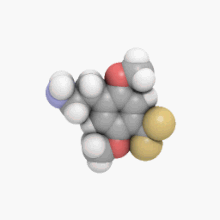2C-TFM

| |

| |
| Names | |
|---|---|
| Preferred IUPAC name
2-[2,5-Dimethoxy-4-(trifluoromethyl)phenyl]ethan-1-amine | |
| Other names
2,5-Dimethoxy-4-(trifluoromethyl)phenethylamine
| |
| Identifiers | |
3D model (JSmol)
|
|
| ChEMBL | |
| ChemSpider | |
PubChemCID
|
|
| UNII | |
CompTox Dashboard(EPA)
|
|
| |
| |
| Properties | |
| C11H14F3NO2 | |
| Molar mass | 249.23 g/mol |
| Melting point | 260 °C (500 °F; 533 K) (hydrochloride)[1] |
Except where otherwise noted, data are given for materials in theirstandard state(at 25 °C [77 °F], 100 kPa).
| |
2C-TFMis apsychedelicphenethylamineof the2C family.It was first synthesized in the laboratory ofDavid E. Nichols.It has also been called2C-CF3,a name derived from thePara-trifluoromethyl group it contains.
Chemistry
[edit]2C-TFM is a code that represents4-trifluoromethyl-2,5-dimethoxyphenethylamine.The full name of the chemical is 2-[2,5-dimethoxy-4-(trifluoromethyl)phenyl]ethanamine.
Dosage
[edit]A psychedelic dosage of 2C-TFM is reported to be 3–5mg.[2]
Effects
[edit]Very little data exists, but some reports suggest 2C-TFM produces psychedelic (hallucinogenic/entheogenic) effects that last between 5 and 7 hours. It is considered to be the strongest 2C variation.[2]
Legality
[edit]United States
[edit]2C-TFM is unscheduled and uncontrolled in the United States, but possession and sales of 2C-TFM could potentially be prosecuted under theFederal Analog Actbecause of its structural similarities to2C-Band2C-T-7.However, 2C-TFM, unlike many otherphenethylamines,has not been widely sold by internet retailers. In the wake ofOperation Web Trypin July 2004, the issue of possession and sales of 2C-TFM and other similar chemicals will probably be resolved in the courtroom as well the fate of this rare but uniquepsychedelic.There have been no reported deaths or hospitalizations from 2C-TFM.
Canada
[edit]As of October 31st, 2016, 2C-TFM is a controlled substance (Schedule III) in Canada.[3]
Pharmacology
[edit]The mechanism that produces the hallucinogenic and entheogenic effects of 2C-TFM is most likely to result from action as a5-HT2Aserotonin receptoragonistin the brain, a mechanism of action shared by all of the hallucinogenictryptaminesandphenethylamines.2C-TFM displaced radiolabelledketanserinfrom 5-HT2A/Creceptors with a Kiof 74.5 nM, as compared to a Kiof 80.9 nM for the more well known 5-HT2AagonistDOI,indicating similar binding affinity at the receptor.[1]The high binding affinity conferred by the 4-trifluoromethyl group is demonstrated by the fact that 2C-TFM is one of the only simple phenethylamines to rival the potency of psychedelic amphetamines like DOI andDOB,in bothin vitrostudies and human trials.[2]
Dangers
[edit]The toxicity of 2C-TFM is not known.
Synthesis
[edit]It is noted in The Shulgin Index Volume 1: Psychedelic Phenethylamines and Related Compounds where the synthesis is written "from 2C-I (with trifluoroacetic anhydride) to 1-(2,5-dimethoxy-4-iodophenyl)-2-(trifluoroacetamido)ethane; (with methyl chlorodifluoroacetate, KF, Cul) to 1-(2,5-dimethoxy-4-trifluoromethylphenyl)-2-(trifluoroacetamido)ethane; (with KOH) to 2C-TFM."[4]The synthesis was published by Nichols and his research team.[1]Since 2C-TFM is usually synthesised from 2C-I and the reaction does not generally consume all of the starting material, samples of 2C-TFM are likely to be contaminated with detectable traces of unreacted 2C-I, which may pose legal issues in jurisdictions where 2C-I is illegal, even though 2C-TFM itself may not be prohibited.
See also
[edit]References
[edit]- ^abcNichols, D. E.; Frescas, S.; Marona-Lewicka, D.; Huang, X.; Roth, B. L.; Gudelsky, G. A.; Nash, J. F. (1994)."1-(2,5-Dimethoxy-4-(trifluoromethyl)phenyl)-2-aminopropane: A Potent Serotonin 5-HT2A/2C Agonist".Journal of Medicinal Chemistry.37(25): 4346–4351.doi:10.1021/jm00051a011.PMID7996545.Archived fromthe originalon 2014-02-02.Retrieved2015-08-29.
- ^abcTrachsel, D. (2012)."Fluorine in psychedelic phenethylamines".Drug Testing and Analysis.4(7–8): 577–590.doi:10.1002/dta.413.PMID22374819.Archived fromthe originalon 2013-12-12.Retrieved2013-12-09.
- ^"Regulations Amending the Food and Drug Regulations (Part J — 2C-phenethylamines)".Canada Gazette.Vol. 150, no. 9. 4 May 2016.
- ^Shulgin, Alexander T.; Tania Manning; Paul F. Daley (2011).The Shulgin Index Volume One Psychedelic Phenethylamines and Related Compounds.Transform Press.ISBN978-0-9630096-3-0.
